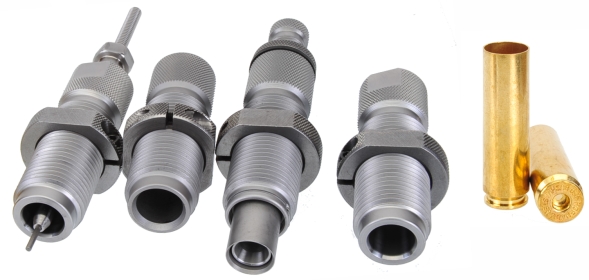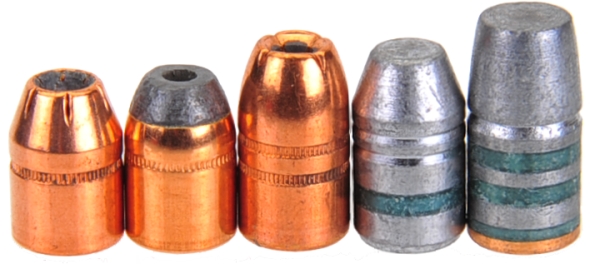
The 450 Bushmaster began as a Jeff Cooper concept and Tim LeGendre’s 45 Professional cartridge. The 45 Professional cartridge is based on the 284 Winchester case, shortened to 1.771″ and tapered to accept a 0.452″ bullet. Working with Hornady for development, Bushmaster licensed the use of the Professional design, shortened to 1.700″ and with its name changed to 450 Bushmaster. The shorter case permitted the use of spire tipped 250 grain bullets without exceeding the capacity of the M16 – AR15 platform. This change extended the cartridges effective range1)2). Are the preceding statements historically accurate? I have no way of knowing. They are extracted from credible hardcopy published sources and, for my purposes, they don’t really matter.
An exercise in relativity….

| Cartridge | Bullet Diameter Inches |
Overall Length Inches |
Capacity Grains H2O |
MAP PSI |
| 45 Auto | 0.451 | 1.275 | 25.0 | 21000 |
| 44 Magnum | 0.429 | 1.610 | 39.5 | 36000 |
| 454 Casull | 0.451 | 1.68 | 46.8 | 65000 |
| 450 Bushmaster | 0.451 | 2.260 | 60.0 | 39160 |
| 460 S&W Magnum | 0.451 | 2.300 | 60.0 | 61931 |
| 458 Socom | 0.458 | 2.310 | 61.0 | 35000 |
| 444 Marlin | 0.429 | 2.570 | 68.0 | 51488 |
| 45-70 Gov’t | 0.458 | 2.550 | 79.0 | 28000 |
Pictured left, the 450 Bushmaster bullying a 45 Auto round. The 450 Bushmaster is a substantial cartridge in terms of capacity. Greater than the 454 Casull, as big as the 460 S&W. If the Bushmaster gives up anything to this high intensity company it is its SAAMI Maximum Average Pressure rating.
This may be one of those situations where a cartridge’s performance is inhibited by its intended firearm. In this case, the direct impingement AR operating system and 5.56 NATO bolt face resulted in 450 Bushmaster’s modest chamber pressure and rebated rim. However, in this case the firearm is bolt action and significantly stronger that the AR and the bolt stroke is significantly longer than the 450 Bushmaster 2.260″ length.
Pay no attention to the cannelures…
Five bullets were selected for handloads, bullets often used and push hard in either a 45 Colt or 454 Casull revolver. Hornady FTX bullets were skipped because of their excessive length and quite unimpressive BC. A 200 grain Hornady FTX has a B.C. of .145, while a 250 grain Hornady HP/XTP has a B.C. of .146. A 250 grain FTX has a B.C. of .210, a 300 grain HP/XTP rates a .200. We will run the external ballistics to confirm, but my best guess is that the B.C. difference is of no consequence within the effective range of the cartridge.
All of the bullets selected have cannelures or crimp grooves. When used with rimmed, heavy recoiling 45 Colt or 454 Casull loads a heavy roll crimp is applied. However, the 450 Bushmaster headspaces on the case mouth, so the cannelures are ignored and a taper crimp is applied. This actually allowed for quite a bit of attitude in setting cartridge overall length. The center bullet is from an older stock of Hornady 300 grain XTP/Mag. Since their production, Hornady has switched to dual cannelures on the 300 grain HP/XTP and a single cannelure for the XTP/Mag with its heavier jacket construction.

To determine a cartridge overall length for each of the bullets selected, each was measure, overall as well as cannelure locations, then each was loaded into a COL gauge and checked for the length each bullet made contact with the rifling leade. An adjustment was to establish a length that would provide safety clearance between bullet and rifling, dependent upon bullet shape.

| Brand | Type | Weight | Length | Crimp 1 Depth |
Crimp 2 | Max Contact Length “ |
Adjusted Max COL “ |
Net Capacity Grains |
| Hornady | HP/XTP | 250 | 0.661 | 0.328 | NA | 2.150 | 2.130 | 49.8 |
| Speer | JHP | 260 | 0.679 | 0.380 | NA | 2.255 | 2.120 | 49.5 |
| Hornady | XTP/Mag | 300 | 0.808 | 0.320 | 0.450 | 2.215 | 2.195 | 46.9 |
| Oregon Trail | Cast FN | 300 | 0.796 | 0.405 | 0.490 | 2.145 | 2.115 | 44.6 |
| Oregon Trail | Cast FN | 360 | 0.931 | 0.530 | NA | 2.150 | 2.120 | 39.3 |
Handloads have been worked up and assembled to a final configuration. We’ll get some data collecting equipment set up and report results for AR level performance in Part 2 and possibly a little further experimentation.

Email Notification